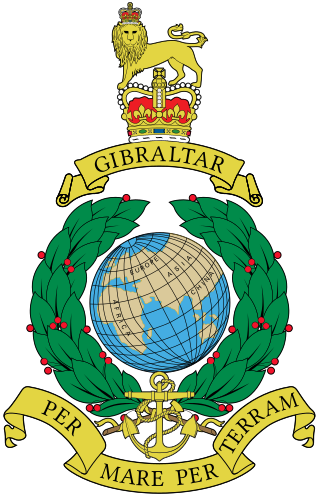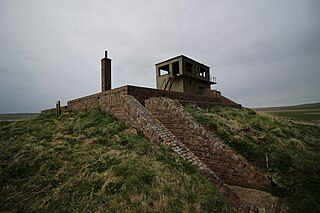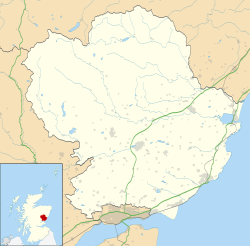
The Royal Marines, also known as the Royal Marines Commandos, and officially as the Corps of Royal Marines, are the United Kingdom's special operations capable commando force, one of the five fighting arms of the Royal Navy, and provide the majority of Special Boat Service (SBS) personnel, and a company strength unit to the Special Forces Support Group (SFSG). The Royal Marines trace their origins back to the formation of the "Duke of York and Albany's maritime regiment of Foot" on 28 October 1664, and the first Royal Marines Commando unit was formed at Deal in Kent on 14 February 1942 and designated 'The Royal Marine Commando'.

HMS Albion (R07) was a 22,000-ton Centaur-class light fleet carrier of the Royal Navy.
45 Commando Royal Marines is a battalion sized unit of the British Royal Marines and subordinate unit within 3 Commando Brigade Royal Marines, the principal Commando formation, under the Operational Command of the Fleet Commander.

Royal Marines Barracks Chivenor is a British military base used primarily by 3 Commando Brigade. It is situated on the northern shore of the River Taw estuary, adjacent to the South West Coast Path, on the north coast of Devon, England. The nearest towns are Barnstaple and Braunton.

Royal Naval Air Station Yeovilton, commonly referred to as RNAS Yeovilton, is a military airbase of the Royal Navy, sited a few miles north of Yeovil, in the English county of Somerset. It is one of two active Fleet Air Arm bases, the other being RNAS Culdrose). RNAS Yeovilton is currently home to the Royal Navy Wildcat HMA2, along with Army Air Corps Wildcat AH1 helicopters, as well as the Royal Navy's Commando Helicopter Force Merlin HCi3/4/4A and Wildcat AH1 helicopters.

The 43 Commando Fleet Protection Group Royal Marines, formerly Comacchio Company Royal Marines (1980–1983), Comacchio Group Royal Marines (1983–2001) and Fleet Protection Group Royal Marines (2001–2012), is a 550-man unit of the Royal Marines responsible for guarding the United Kingdom's nuclear weapons. The unit, based at HM Naval Base Clyde, is part of 3 Commando Brigade.

The Commander-in-Chief Fleet (CINCFLEET) was the admiral responsible for the operations of the ships, submarines and aircraft of the British Royal Navy from 1971 until April 2012. The post was subordinate to the First Sea Lord, the professional head of the Naval Service. In its last years, as the Navy shrank, more administrative responsibilities were added.

The Commander United Kingdom Strike Force is a senior post in the Royal Navy.

HMAS Albatross is the main naval air station for the Royal Australian Navy's (RAN) aviation branch, the Fleet Air Arm. The base, located near Nowra, New South Wales, was formally established in May 1942 as Royal Australian Air Force (RAAF) base RAAF Nowra, then was transferred to the Royal Navy as HMS Nabbington in 1944, and operated as a naval air station until it was decommissioned in late 1945. In 1948, the airfield was commissioned into the RAN as HMAS Albatross, as the primary shore base for the Fleet Air Arm. Since 2011, five squadrons of the Fleet Air Arm operate from Albatross. The current commander of the base is Captain Robyn Phillips, RAN.

29 Commando Regiment, Royal Artillery is the Commando-trained unit of the British Army's Royal Artillery, based in Plymouth. The regiment is under the operational control of 3 Commando Brigade, to which it provides artillery support and gunnery observation.

HMS Sultan is a shore base of the Royal Navy in Gosport, Hampshire, England. It is the primary engineering training establishment for the Royal Navy and home to the Network Rail Advanced Apprenticeship Scheme and the EDF Energy engineering maintenance apprenticeship.

Historically, Scotland has a long military tradition that predates the Act of Union with England. Its soldiers form part of the armed forces of the United Kingdom, more usually referred to domestically within Britain as the British Armed Forces.

Operation Musketeer was the Anglo-French plan for the invasion of the Suez canal zone to capture the Suez Canal during the Suez Crisis in 1956. The operation had initially been given the codename Operation Hamilcar, but this name was quickly dropped when it was found that the British were painting an air recognition letter H on their vehicles, while the French, who spelled Hamilcar differently, were painting an A. Musketeer was chosen as a replacement because it started with M in both languages. Israel, which invaded the Sinai peninsula, had the additional objectives of opening the Straits of Tiran and halting fedayeen incursions into Israel. The Anglo-French military operation was originally planned for early September, but the necessity of coordination with Israel delayed it until early November. However, on 10 September British and French politicians and Chiefs of the General Staff agreed to adopt General Charles Keightley's alterations to the military plans with the intention of reducing Egyptian civilian casualties. The new plan, renamed Musketeer Revise, provided the basis of the actual Suez operation.
The history of the Royal Marines began on 28 October 1664 with the formation of the Duke of York and Albany's Maritime Regiment of Foot soon becoming known as the Admiral's Regiment. During the War of the Spanish Succession the most historic achievement of the Marines was the capture of the mole during the assault on Gibraltar in 1704. On 5 April 1755, His Majesty's Marine Forces, fifty Companies in three Divisions, headquartered at Portsmouth, Chatham and Plymouth, were formed by Order of Council under Admiralty control.
The Royal Marines Volunteer Cadet Corps (RMVCC) is part of the Royal Navy's Volunteer Cadet Corps. There are units (Divisions) in Arbroath, Chivenor, Gosport, Lympstone, Portsmouth, and Plymouth.
This is an order of battle listing the British and Commonwealth forces involved in the Indonesia-Malaysia confrontation (1962–66).
In 1989 the Royal Navy was under the direction of the Navy Department in the UK Ministry of Defence. It had two main commands, CINCFLEET and Naval Home Command.

Royal Naval Air Station Twatt, is a former Royal Navy Air Station located near Twatt, Orkney, Scotland. It was built by the Admiralty and was commissioned on 1 April 1941. On 1 January 1942 it became an independent command as HMS Tern. The airbase was designed to provide accommodation for disembarked Front-Line squadrons and accommodation for disembarked Ship's Flight Aircraft and was home to the Home Fleet Fleet Requirements Unit, 771 Naval Air Squadron.

This is a list of active military units, bases and barracks in Scotland. The armed forces in Scotland include the military bases and organisation in Scotland or associated with Scotland. This includes servicemen and women from Scotland and Scottish regiments and brigades of the British Armed Forces. The Military in Scotland includes the three services. The Army which has bases across Scotland, the RAF and the Navy.
















